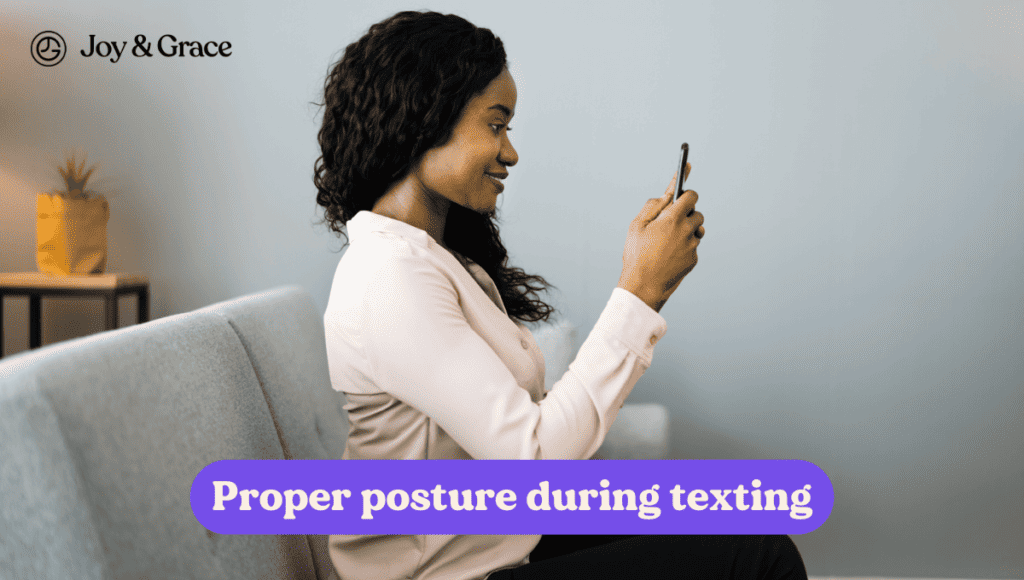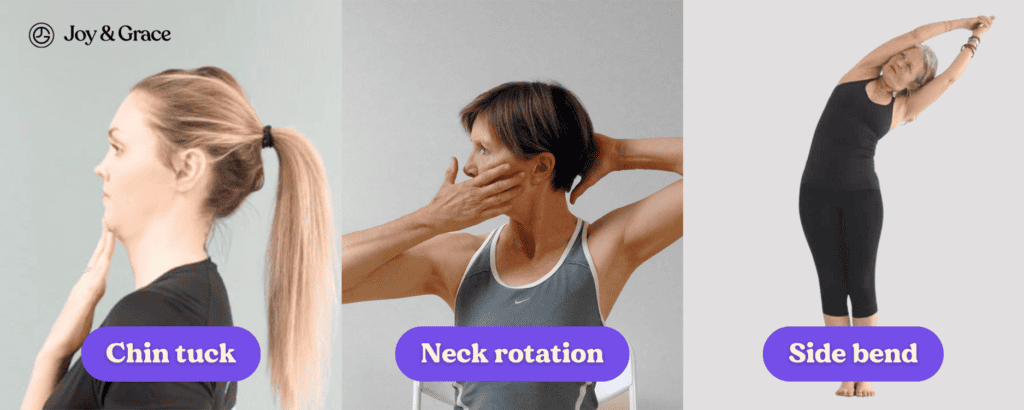In the age of screens and digital engagements, neck pain due to poor posture isn't just common—it's a modern-day epidemic. But what if relief, health, and comfort lie in small daily adjustments? Dive in as we unravel the link between our tech habits, posture, and the journey to a pain-free neck.
Does Poor Posture Cause Neck Pain?
Yes, poor posture can indeed cause neck pain. Poor posture and neck pain have been linked in many studies, but we will only talk about one of the most recent ones here.
Researchers in Hong Kong conducted a study where they took photos of people with and without neck pain to measure their upper back and neck angles. They found that:
- Those complaining of neck pain had more slumped upper backs and forward head postures.
Additionally, the worse the posture, the more severe the neck pain and disability.
Of the two postures, a hunched upper back was more predictive of neck pain than a forward head position.
So, if you're suffering from neck aches, improving your upper back posture may be key.
What Kind of Posture Causes Neck Pain?

The study we mentioned earlier mentioned that a hunched upper back and forward head posture are strongly linked to neck pain. These awkward postures likely cause neck pain by straining the muscles and putting extra stress on the cervical spine.
For example,
- Slouching over a computer at work can excessively stress the neck.
- Prolonged "text neck" from looking down at phones strains neck muscles over time.
- Poor sitting posture without back support causes the neck to bend forward to hold up the head.
- Doing physical work hunched over or carrying heavy weights unevenly can also strain the neck and shoulders.
- Even walking with slumped shoulders and a lowered gaze can create muscle tension in the neck.
The takeaway is that maintaining proper upright posture during daily activities is key to preventing neck pain.
You should pay attention to your sleeping posture as well. Let’s discuss this in more detail.
Does Sleeping Posture Affect Neck?
Your sleeping posture can significantly impact your neck health and, over time, can lead to pain or discomfort.
When sleeping the wrong way, your neck may bend, kink, or twist in a way that isn't normal. This makes the muscles and ligaments in your neck and shoulders work harder than they should. This can cause stiffness and discomfort upon waking, which may persist throughout the day.
Experts recommend keeping your head aligned with your spine while sleeping to avoid neck pain.
You can do this by sleeping on your back with a mattress that supports your neck's natural curve or on your side with a pillow that keeps your neck straight.
Meanwhile, the worst is often the stomach-sleeping position. This position causes the head to be turned to one side for extended amounts of time, making the neck and shoulder muscles tighten and hurt.
To sum it up, there are many risk factors that can contribute to poor sleeping posture, including:
- Needing more support from your mattress or pillow,
- Sleeping on your stomach, or
- Using a pillow with too much or too little slope
Changing your sleeping posture may seem unusual at first, but it should get easier and help with neck pain.
Now that we've explored common postures that contribute to neck pain (with sleeping included), let's discuss the symptoms this poor alignment causes.
What are the Symptoms of Bad Posture in Neck?

Poor posture can significantly contribute to neck pain due to the strain on the muscles and ligaments in that area. Some of the telltale signs hinting that you may have poor posture are:
- Chronic pain in the neck. This can range from a dull, consistent ache to intermittent, sharp pains. Your posture may be to blame if you're experiencing persistent, regular neck discomfort.
- Reduced range of movement: Incorrect posture can inhibit your neck movement fully and freely. This might feel like a slight decrease over time or a sudden change.
- Headaches: Poor neck posture may contribute to long-term headaches, especially tension headaches.
- Feelings of tightness or discomfort: If you have improper posture, your neck and shoulder muscles may be under constant stress. This can make these areas feel tight or uncomfortable.
- Fatigue: Being slouched over can greatly drain your energy. Because your body and back muscles have to work harder to support you, you may feel more tired than you would otherwise.
- Tingling or numbness: Poor posture can pressure the nerves in your neck, leading to tingling, numbness, or even pain radiating down your arm. However, many of these symptoms can have other causes as well, so it's recommended to consult your doctor if the symptoms continue despite postural improvements.
- Rounded shoulders: This physical symptom is a clear visual sign of poor posture.
What Does Neck Pain from Bad Posture Feel Like?
Neck pain from bad posture may feel like:
- Dull, achy pain in the neck muscles
- Stiffness and reduced range of motion in the neck
- Sharp, stabbing pains when turning the head
- Headache at the base of the skull
- Pain or numbness radiating down the shoulders and arms
- Muscle spasms and tightness in the neck and shoulders
- Increased pain when holding the neck in one position
The onset of pain is often gradual, intensifying over time as the body encounters constant strain and improper alignment.
How Do You Check Neck Posture?

There are several simple ways to analyze your neck posture.
Start by looking at a mirror from the side. Your ears should be aligned with your shoulders, not pushed out in front.
Another method is the 'tragus to wall test.' To do this test, stand with your heels and buttocks pressed against a wall. Keep your knees straight and tuck your chin in slightly. Using a retractable steel tape measure, measure the horizontal distance between the right tragus (the small cartilage nub in front of your ear canal) and the wall.
The further the tragus is from the wall, the greater the degree of forward (and abnormal) head posture.
There are also additional ways to assess proper posture, such as:
- Clinical assessment that uses anatomical landmarks. Looking at anatomical landmarks can make it easy to see improper body alignment. They include measurements such as:
- Shoulder position,
- Knee interspace and
- Ankle position
- Radiographic techniques. Employing advanced imaging technologies gives an in-depth view of your spinal alignment. It provides a high degree of accuracy in detecting postural anomalies.
- Evaluation of the craniovertebral angle (CVA) is one of the most reliable methods. It measures the angle between
- a straight line connecting the spinous process of C7 to the tragus of the ear and
- the horizontal line passing through the spinous process of the C7.
A CVA angle of less than 48–50 degrees is defined as a Forward head posture.
Can Bad Posture Cause Severe Neck Pain?
Yes, poor posture can sometimes contribute to severe neck pain, depending on the circumstances. However, severe neck pain should not be taken lightly and requires prompt evaluation by a healthcare professional.
Over time, poor posture can alter the natural anatomy of the neck and spine.
For example, prolonged forward head posture stretches out the neck ligaments, allowing further slouching. Slouching also increases the forward curvature of the upper spine, flattens the natural spinal curves, and causes uneven muscle imbalances.
These postural adaptations place abnormal forces on the vertebrae, discs, and muscles. This could then lead to potentially severe neck injuries and disc degeneration. Seeking early treatment is important to correct posture before permanent damage occurs.
How Long Does Neck Pain from Bad Posture Last?
The duration of this pain largely depends on how poor the posture is, the specific causes of it, and the individual anatomy.
Minor neck pain can typically subside within a day or two with adequate rest, stretching, and improved sitting habits.
But if you have had bad posture and neck and shoulder pain for a long time, it may take weeks or months to feel completely better. This is because bad posture can change the shape of the spine over time, which can cause pain, stress, and tightness in the neck and shoulders.
With the right treatment, neck pain caused by bad posture can get better faster.
How Long Does It Take to Fix Bad Neck Posture?
Improving posture is an ongoing process that requires discipline and consistency.
On average, it takes about four to six weeks to notice a big difference, but the exact time depends on the person.
In some instances, it could take up to 12 weeks to see real changes.
Can Neck Posture be Corrected?
Yes, neck posture can be corrected with consistent actions and ergonomic adjustments.
One important thing to remember is that posture is a habit, and it takes time and practice to break bad ones. Start by paying attention to the way you sit and stand, and make a conscious effort to adjust your posture throughout the day. Additionally, make sure to use ergonomic furniture and take regular breaks.
Let's go through some specific tips to improve posture in common scenarios that contribute to neck pain.
Working at a Desk
When we hunch or slouch, excessive pressure is applied to the neck and shoulder muscles, often leading to strain and pain. To fix this, you might want to change the ergonomics of your office. Make sure that the heights of your screen, chair, and desk allow you to look straight ahead while you work.
Texting

When texting on your phone, it's easy to fall into a forward head posture that strains the neck over time. To avoid "text neck," be mindful to keep your head balanced over your shoulders instead of jutting forward. Periodically retract your neck by gently pulling your head back to align over your torso.
Also, focus on keeping your shoulders back instead of rounded forward. Stand upright or sit with back support while texting to maintain good posture. Take regular breaks by putting your phone down and stretching your neck. Devices that attach to your phone to raise it closer to eye level can also help relieve neck strain. Developing ongoing awareness of your posture while texting can help prevent chronic neck issues.
Manual Labor
When doing physical tasks like heavy lifting, gardening, or housework, be mindful of maintaining proper posture to avoid neck strains. Keep your head balanced over your spine rather than jutting your chin forward as you work. Avoid hunching or rounding your shoulders. Stand upright with your feet shoulder-width apart for balance.
When lifting objects, squat with your legs rather than bending over at the waist. Keep your back straight and engage your core muscles. Avoid twisting your neck to the side - pivot your whole body instead. Take breaks to stretch and reset your posture.
Sitting
Poor seating posture can also have a negative effect on your neck health. Avoid slouching or slumping in your seat, as this allows your head to tilt forward and strain your neck. Maintain an upright seated posture with your shoulders back, head balanced over the spine, and lower back supported. Take short breaks every 30 minutes to get up, stretch, and reset your posture. You can also use a small lumbar pillow to support your lower back when sitting.
Walking
It's important to maintain proper posture even during everyday activities like walking. To fix neck posture while walking:
- Stand tall with your ears aligned over your shoulders, avoiding the forward head position.
- Keep your chin parallel to the ground; don't tilt it down or jut it forward.
- Pull your shoulders back slightly and relax them away from your ears.
- Engage your core muscles for support and stability.
- Look straight ahead, not down at the ground.
- Take shorter strides and walk smoothly rather than in long, limping steps.
- Wear supportive shoes with cushioning and avoid high heels that alter posture.
How Do You Fix Neck Pain from Poor Posture?

- Stretching exercises. Perform gentle neck stretches and exercises daily, such as:
- chin tucks,
- neck rotations, and
- side bends.
Targeted stretches can increase range of motion, relax muscles, and prevent neck stiffness. Start slowly and avoid overstretching.
- Limit screen time. Take regular short breaks when working at a desk or using devices to avoid prolonged periods of strain on the neck. Follow the 20-20-20 rule: every 20 minutes, look away at something 20 feet away for 20 seconds.
- Stay hydrated. Stay well hydrated by drinking plenty of water throughout the day.
Dehydration causes muscles to lose flexibility and become tight or sore. Proper hydration keeps muscles loose and supple, allowing for greater mobility. Aim for the recommended daily intake of water based on your weight and physical activity levels:- About 15.5 cups (3.7 liters) of fluids a day for men and
- about 11.5 cups (2.7 liters) of fluids a day for women.
- Seek medical advice. If pain persists, consult with a physical therapist or chiropractor for specialized care.
What is the Fastest Way to Relieve Neck Pain from Poor Posture at Home?
People who spend a lot of time working on computers or hunching over their phones often have bad posture, which can cause long-term neck pain. However, there are simple and effective home solutions to alleviate this discomfort.
- Cold or hot compress. One useful method is the application of heat to the affected area. A warm shower or hot compress can soothe stiff muscles, providing immediate relief from neck and shoulder pain.
- Over-the-counter pain relief. Non-steroidal anti-inflammatory drugs (NSAIDs) often provide effective relief for minor pains.
- Massage. Gentle neck massages can help release tension and improve blood circulation.
Takeaway
The connection between a slumped upper back and forward head posture and neck discomfort is well established.
Simple actions, from adjusting workspaces to practicing mindfulness about how we sit, stand, or even walk, can play a vital role in correcting posture.
Regular stretches, ergonomic tools, and hydration are essential for relief and prevention.
In the end, neck pain can be prevented or lessened by being aware of how important posture is and making specific changes to daily habits.















